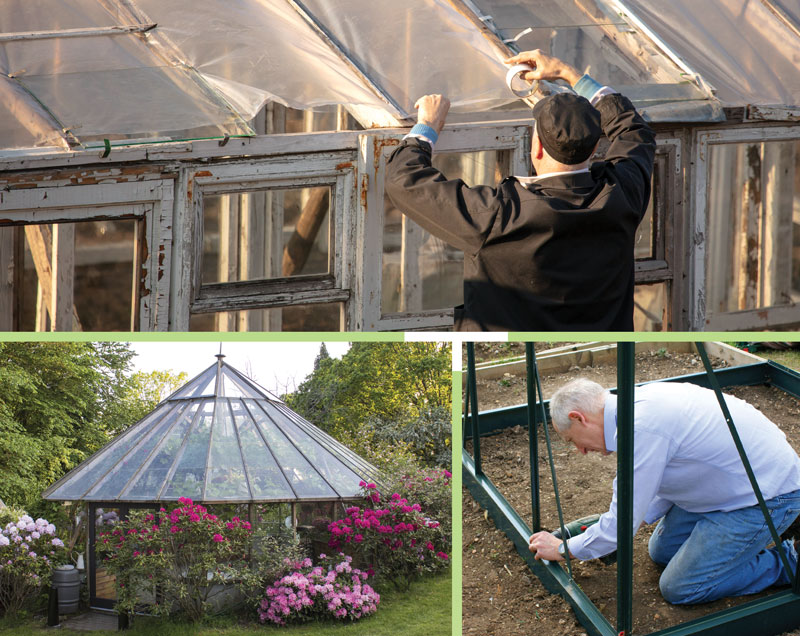
Whether you are a planting pro or a sapling novice, you may dream of creating an environment in which your flora and fauna is more likely to succeed. Greenhouses have surged in popularity as people seek hobbies that keep them close to home but still allow them to get outside.
A greenhouse lets you control your plants’ environment, and can be built from a kit, from upcycled materials or from the ground up depending on your skill level. Before deciding if a greenhouse project is for you, consider the following fundamentals that will be involved in constructing one.
Choose a location. Sufficient sun exposure, proper drainage and access to water are keys in site selection, with the ideal spot allowing the longer sides of your greenhouse to face east and west. Having electricity nearby is not a requirement but can be a bonus.
Consider the construction. If your intention is a long-lasting structure, you’ll want to consider at least a ground contact-rated wood base if not a cement one. If you prefer not to lay a foundation, a portable greenhouse may be for you. You’ll need to clean and level your foundation site either way, and you might consider using landscape fabric, gravel or bricks as your greenhouse floor to allow suitable drainage and avoid muddy messes in your future.
For the greenhouse frame, popular options are wood, PVC piping or aluminum steel, and those choices will impact the material you’ll use to cover your greenhouse. Common wall material for greenhouses ranges from glass paneling to polycarbonate sheets or even plastic sheeting, with each offering its own pros and cons regarding durability and expense.
Glass greenhouses are popular and can be built from ready-made plans or you can use your own creativity. For simplicity’s sake, one could construct an A-frame roof with rafters, building the walls on the ground before raising them into place and installing tempered or safety glass walls.

A greenhouse that’s green itself? A trendy DIY project is to collect and upcycle several old doors with their glass intact, securing them together to construct greenhouse walls. Because these walls will be heavy, a foundation of some sort is a must.
Once doors are fastened together, any gaps between them will need to be filled with sealant, and painting all the doors one color will beautify this DIY. A slanted roof can be made from some lightweight, waterproof material.
If this introduction to greenhouse options has your head spinning before you’ve even read step-by-step construction instructions, a greenhouse kit may be a better solution for you. Assembly directions and supplies will be provided in each of many greenhouse kit sizes and styles, from wood, resin, metal and more.
A kit leaves less room for error. Start by unpacking all the provided materials, comparing them to the supply list provided in the kit. Then, it’s best to begin with the base and corner uprights of your greenhouse.
Next, you will likely attach your roof frame, then install wall uprights and the roof rafters. The manufacturer should describe the best order of construction to ensure a stable greenhouse outcome.
Wall panels, doors and supports will follow, with windows also offered in some kits. While you may have used a ready-made greenhouse design, you can still customize the space to your style with plant shelving, tables, benches, tool organizers and other gardening gear.
There’s no shame in starting small. If even a kit sounds overwhelming, you need not give up your greenhouse dreams. A number of mini greenhouses are on the market, as are several construction options online for these tiny plant homes.
One option is to cut PVC piping to your desired size, join them with PVC fittings and cover the structure with plastic sheeting. Lightweight and portable, the PVC greenhouse is a mini masterpiece.
Akin to the DIY greenhouse made of doors idea, a mini plant house can be made from six windows of the same shape and size. A wooden frame will need to be built to dimensions that will hold the windows, with an A-frame to support the roof.
Five of the windows should be attached to the frame, followed by the sixth window attached with a hinge on one side where you can open and access the plants you keep inside.
As with any project, detailed instructions abound online. Consider which greenhouse option is the best match to your construction skills and go from there. Whatever its size, shape or design, your plants will thank you by blooming as they’ve never done before.
Source: https://www.homedepot.com/c/ah/how-to-build-a-greenhouse/9ba683603be9fa5395fab905443ffce.
Written by Angel Morris

You must be logged in to post a comment.